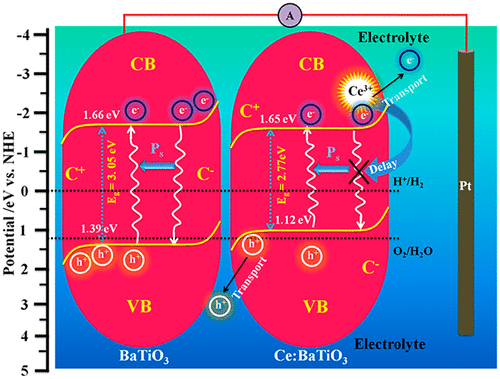当前位置:
X-MOL 学术
›
ACS Sustain. Chem. Eng.
›
论文详情
Our official English website, www.x-mol.net, welcomes your
feedback! (Note: you will need to create a separate account there.)
Built-in Electric Field Assisted Photocatalytic Dye Degradation and Photoelectrochemical Water Splitting of Ferroelectric Ce Doped BaTiO3 Nanoassemblies
ACS Sustainable Chemistry & Engineering ( IF 7.1 ) Pub Date : 2019-06-12 00:00:00 , DOI: 10.1021/acssuschemeng.9b00679 P. Senthilkumar 1 , D. Arockiya Jency 2 , T. Kavinkumar 3 , D. Dhayanithi 4 , S. Dhanuskodi 1 , M. Umadevi 2 , S. Manivannan 3 , N. V. Giridharan 4 , V. Thiagarajan 5 , M. Sriramkumar 6 , K. Jothivenkatachalam 6
ACS Sustainable Chemistry & Engineering ( IF 7.1 ) Pub Date : 2019-06-12 00:00:00 , DOI: 10.1021/acssuschemeng.9b00679 P. Senthilkumar 1 , D. Arockiya Jency 2 , T. Kavinkumar 3 , D. Dhayanithi 4 , S. Dhanuskodi 1 , M. Umadevi 2 , S. Manivannan 3 , N. V. Giridharan 4 , V. Thiagarajan 5 , M. Sriramkumar 6 , K. Jothivenkatachalam 6
Affiliation

|
In the field of environmental remediation and sustainability, the built-in electric field of ferroelectrics has been regarded as a promising strategy to enhance photocatalytic (PC) dye degradation and photoelectrochemical (PEC) water splitting. Here, we report on Ce-doped BaTiO3 (BT) nanoassemblies prepared by a hydrothermal route. X-ray diffraction reveals the phase transformation from tetragonal to cubic on the sintering temperature and Ce doping. From X-ray photoelectron spectroscopy (XPS), the oxygen vacancies are found to be maximum for 4 mol % of Ce concentration. The ferroelectric and piezoelectric measurements disclose a higher remnant polarization (1.76 μC cm–2) and d33 coefficient (15 pCN–1) at 4 mol % due to the built-in electric field. Thus, we observed a significantly improved PC dye degradation with the rate constant (k) of 0.0139 m–1 (methylene blue), 0.0147 m–1 (methyl violet) at 4 mol %, and 0.0117 m–1 (congo red) at 6 mol %. PEC water splitting showed that the photoanode fabricated at 4 mol % of Ce exhibits enriched photocurrent density (1.45 mA cm–2), impressive early onset of water oxidation (−0.504 V), and hydrogen gas evolution (22.50 μmol h–1 cm–2). Poling studies display a significant enhancement in both PC and PEC properties indicating the built-in electric field assisted activities of Ce-doped BT nanoassemblies. The underlying mechanisms behind the degradation efficiency and improved photocurrent density are established via the built-in electric field facilitating charge carrier detachment and transport as evidenced by the photoluminescence decay and XPS valence band spectra.
中文翻译:

内置电场辅助的铁掺杂铈掺杂BaTiO 3纳米组件的光催化染料降解和光电化学水分解
在环境修复和可持续性领域,铁电体的内置电场已被视为增强光催化(PC)染料降解和光电化学(PEC)水分解的有前途的策略。在这里,我们报告通过水热法制备的Ce掺杂BaTiO 3(BT)纳米组件。X射线衍射揭示了在烧结温度和Ce掺杂下从四方相向立方相的转变。从X射线光电子能谱(XPS),发现氧空位在Ce浓度为4 mol%时最大。铁电和压电测量显示出更高的残余极化(1.76μCcm –2)和d 33系数(15 pCN –1))由于内置电场,在4 mol%时)。因此,我们观察到PC染料的降解得到了显着改善,速率常数(k)为0.0139 m –1(亚甲基蓝),0.0147 m –1(甲基紫)(4摩尔%)和0.0117 m –1(刚果红)。 6摩尔%。PEC的水分解表明,以4 mol%的Ce制备的光阳极显示出丰富的光电流密度(1.45 mA cm –2),令人印象深刻的水氧化早期发作(-0.504 V)和氢气析出(22.50μmolh –1 cm – 2个)。极化研究显示PC和PEC的性能均得到显着增强,表明Ce掺杂的BT纳米组件具有内置的电场辅助活性。降解效率和改善的光电流密度背后的潜在机制是通过内置电场建立的,该电场促进电荷载流子的分离和传输,如光致发光衰减和XPS价带谱所证明的。
更新日期:2019-06-12
中文翻译:

内置电场辅助的铁掺杂铈掺杂BaTiO 3纳米组件的光催化染料降解和光电化学水分解
在环境修复和可持续性领域,铁电体的内置电场已被视为增强光催化(PC)染料降解和光电化学(PEC)水分解的有前途的策略。在这里,我们报告通过水热法制备的Ce掺杂BaTiO 3(BT)纳米组件。X射线衍射揭示了在烧结温度和Ce掺杂下从四方相向立方相的转变。从X射线光电子能谱(XPS),发现氧空位在Ce浓度为4 mol%时最大。铁电和压电测量显示出更高的残余极化(1.76μCcm –2)和d 33系数(15 pCN –1))由于内置电场,在4 mol%时)。因此,我们观察到PC染料的降解得到了显着改善,速率常数(k)为0.0139 m –1(亚甲基蓝),0.0147 m –1(甲基紫)(4摩尔%)和0.0117 m –1(刚果红)。 6摩尔%。PEC的水分解表明,以4 mol%的Ce制备的光阳极显示出丰富的光电流密度(1.45 mA cm –2),令人印象深刻的水氧化早期发作(-0.504 V)和氢气析出(22.50μmolh –1 cm – 2个)。极化研究显示PC和PEC的性能均得到显着增强,表明Ce掺杂的BT纳米组件具有内置的电场辅助活性。降解效率和改善的光电流密度背后的潜在机制是通过内置电场建立的,该电场促进电荷载流子的分离和传输,如光致发光衰减和XPS价带谱所证明的。





















































 京公网安备 11010802027423号
京公网安备 11010802027423号